iwo jima
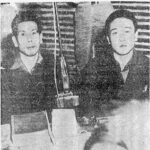
 When a soldier is told to guard an area for his country, he does just that, but on this occasion, this job of “guarding” an area, or an island in this case, was taken to extremes. For a time, the Allies struggled against the Japanese, but by 1945, the tide of World War II had turned decisively against Japan. The Japanese got really nervous as the Americans advanced across the Pacific, drawing ever closer to the Japanese home islands. The American strategists set their sights on Iwo Jima, a small volcanic island about 750 miles south of Tokyo. They saw it as a suitable staging area for an eventual invasion of Japan. Of course, the Japanese were very aware of the threat posed by Iwo Jima landing in American hands. So, they knew they had to garrison the island.
When a soldier is told to guard an area for his country, he does just that, but on this occasion, this job of “guarding” an area, or an island in this case, was taken to extremes. For a time, the Allies struggled against the Japanese, but by 1945, the tide of World War II had turned decisively against Japan. The Japanese got really nervous as the Americans advanced across the Pacific, drawing ever closer to the Japanese home islands. The American strategists set their sights on Iwo Jima, a small volcanic island about 750 miles south of Tokyo. They saw it as a suitable staging area for an eventual invasion of Japan. Of course, the Japanese were very aware of the threat posed by Iwo Jima landing in American hands. So, they knew they had to garrison the island.
Ymakage Kufuku and Matsudo Linsoki were two Japanese machine gunners assigned to the island’s garrison. I can only imagine how they must have felt, knowing that the attack was imminent, and that they could only sit and wait for it. In February of 1945, Iwo Jima was invaded in one of the fiercest and bloodiest battles of the entire Pacific War. The Japanese soldiers fought frantically, almost to the last man. Japanese soldiers were taught that it was more honorable to die that survive, if they lost the war. They were taught that rather than surrender, the honorable thing to do was to commit suicide, so out of a garrison of 21,000 Japanese, nearly 20,000 died before the island was declared secured.
Kufuku and Linsoki were among the few Japanese soldiers who didn’t die in the fighting and didn’t commit suicide. They also believing what their government told them about Americans torturing and killing prisoners, so they were too afraid to surrender. The two men felt like they had no choice but to go underground. They also expected that soon the Japanese would be able to take the island back, so they hid during the day in the multitude of tunnels that were all over the island. They came out at night pilfer food and other necessaries from the American garrison’s supply and trash dumps. It was a tough kind of life, but by doing this, Kufuku and Linsoki managed to survive for a long time in a barren and inhospitable island that was mighty short on both vegetation and game. The Americans weren’t interested in exploring Iwo Jima’s hard landscape, a fact that allowed the two Japanese soldiers to go unnoticed for years.
Finally, on January 6th, 1949, two US Air Force corporals in a Jeep spotted a couple of pedestrians in uniforms that looked to be a few sizes too big. The men were walking alongside a road. The soldiers thought the men were Chinese laborers. The men spoke no English and they didn’t seem to want to talk, but the American airmen just assumed they were hitchhiking to the island’s main base and gave them a lift. They dropped them off in front of the garrison’s headquarters building. That probably left Kufuku and Linsoki a little bit unnerved. Nevertheless, they didn’t want to seem suspicious, so they wandered around the American base for hours, at least until a passing American sergeant realized that they were Japanese and took them in. The men were 
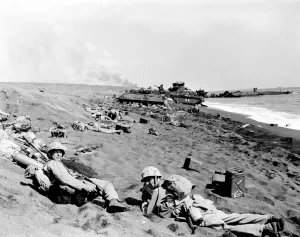 interrogated, and afterward, they took their captors to their hideout. There, to their amazement, the Americans found a cave richly stocked with canned foods, flashlights, batteries, uniforms, boots, shoes, socks, and other goods that the pair had been pilfering over the years. I’m quite sure they recognized some of the items from the base. While the Japanese soldiers did no real harm, their self-imposed secret mission had come to an end.
interrogated, and afterward, they took their captors to their hideout. There, to their amazement, the Americans found a cave richly stocked with canned foods, flashlights, batteries, uniforms, boots, shoes, socks, and other goods that the pair had been pilfering over the years. I’m quite sure they recognized some of the items from the base. While the Japanese soldiers did no real harm, their self-imposed secret mission had come to an end.

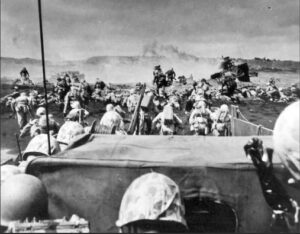 The taking of vital ground is an important, if not essential part of war. In World War II, Iwo Jima was vital ground. It was prime real estate on which to build airfields to launch bombing raids against Japan, just 660 miles away. The Japanese had it, and the Americans needed it. So, they devised a plan to evict the, then current occupiers, so they could have it. The planned attack was called Operation Detachment, and the plan was to invade Iwo Jima thus putting the Allies in a better position to attack Japan.
The taking of vital ground is an important, if not essential part of war. In World War II, Iwo Jima was vital ground. It was prime real estate on which to build airfields to launch bombing raids against Japan, just 660 miles away. The Japanese had it, and the Americans needed it. So, they devised a plan to evict the, then current occupiers, so they could have it. The planned attack was called Operation Detachment, and the plan was to invade Iwo Jima thus putting the Allies in a better position to attack Japan.
The problem was that Iwo Jima was well fortified, both above and below ground…with a force that was 21,000 strong. The US Marines had to find out where the Japanese strongholds were on the island, so the invasion would take place is several phases. The United States had to be patient in the days leading up to the actual invasion, but they also had to apply pressure to keep the Japanese off guard.
To apply pressure, the Americans began bomber raids using B-24 and B-25 bombers in June 1944. The raids continued for 74 days. It was the longest pre-invasion bombardment of the war. Anytime bombing continues for that long, it has to be stressful for those in the bomb zone. The constant threat of falling bombs, and never knowing if they will land on you next, would make every day stressful. The bombing was necessary because of the extent to which the Japanese fortification of the island, above and below ground, including a network of caves.
Next came the Frogmen phase. “Frogmen” or Underwater Demolition Teams were dispatched by the Americans just before the actual invasion. The plan was to for the frogmen to draw fire from the Japanese, thus giving away many of their “secret” gun positions. Of course, as you can imagine, this was basically a suicide mission for the Underwater Demolition Teams. The amphibious landings of Marines began the morning of February 19, 1945, as the secretary of the navy, James Forrestal, accompanied by journalists, surveyed the scene from a command ship offshore. As the Marines made their way onto the island, seven Japanese battalions opened fire on them. By evening, more than 550 Marines were dead and more than 1,800 were wounded. It took four more days and many more casualties to capture of Mount Suribachi, the highest point of the island and bastion of the Japanese defense. While the taking of Iwo Jima was vital and those who fought and died there willingly gave 
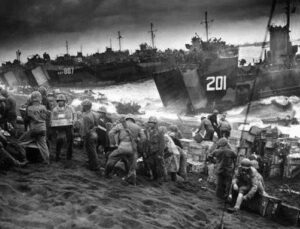 their lives for it, I have to think that it was a bittersweet victory, because of so many lives lost. Much like the D-Day storming of the beaches of Normandy, Iwo Jima was a suicide mission that was vital to the outcome of the war. The photo of the raising of the American flag on Iwo Jima, won the Pulitzer Prize for the photographer who took it, but I’m sure it was a photograph he would rather not have taken, considering the loss of life.
their lives for it, I have to think that it was a bittersweet victory, because of so many lives lost. Much like the D-Day storming of the beaches of Normandy, Iwo Jima was a suicide mission that was vital to the outcome of the war. The photo of the raising of the American flag on Iwo Jima, won the Pulitzer Prize for the photographer who took it, but I’m sure it was a photograph he would rather not have taken, considering the loss of life.
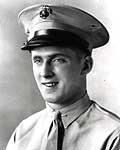 For Corporal Charles Joseph Berry, March 3, 1945 was just another day in the trenches…at least that was how it began. By days end, the war would be all over for Corporal Berry…as would his life. At this point, many people would expect that Corporal Berry would be “just another war statistic,” and they would be right, to a small degree. Corporal Berry was a war statistic, but it was the way he died that changed everything…that made him a hero!!
For Corporal Charles Joseph Berry, March 3, 1945 was just another day in the trenches…at least that was how it began. By days end, the war would be all over for Corporal Berry…as would his life. At this point, many people would expect that Corporal Berry would be “just another war statistic,” and they would be right, to a small degree. Corporal Berry was a war statistic, but it was the way he died that changed everything…that made him a hero!!
Charles Joseph Berry was born on July 10, 1923 in Lorain, Ohio, and graduated from Clearview High School in Lorain in 1941. After graduation he went to work as a truck driver for a moving company. When World War II broke out, Corporal Berry enlisted in the Marine Corps in Cleveland, Ohio, on October 1, 1941. He was 18 years old. He was sent to Parris Island, South Carolina for basic training. Following his basic training, he was stationed to the Marine Barracks at Quantico, Virginia, but shortly afterwards was ordered to the Marine Barracks, New River, North Carolina, for parachute training. He was promoted to private first class on June 2, 1942, after qualifying as a parachutist.
On March 11, 1943, PFC Berry sailed from San Diego, California, arriving later that month in New Caledonia with the 1st Parachute Battalion. He left New Caledonia in September 1943, arriving in the Solomon Islands a few weeks after his departure. Then, in October 1943, he went to Vella La Vella, where he remained for one month. In November 1943, he landed at Bougainville, and during that campaign, took part in the raid at Koairi Beach and in the Empress Augusta Bay action. Prior to returning to the United States in February 1944, he spent a short time at Guadalcanal. Following his arrival at Camp Elliott, San Diego, he joined the newly organized 5th Marine Division in early 1944. In July he departed for the Hawaiian Islands with that division. He was advanced to corporal on July 22, 1944. He landed on Iwo Jima on D-Day, February 19, 1945.
On March 3, 1945, Corporal Berry was killed during a battle that would win him the Medal of Honor. Corporal Berry while stationed in the front lines, manned his weapon with alert readiness as he maintained a constant vigil with other members of his guncrew during the hazardous night hours of March 2nd. Infiltrating Japanese soldiers launched a surprise attack shortly after midnight in an attempt to overrun his position. Corporal Berry engaged in a pitched hand-grenade duel, returning the dangerous weapons with prompt and deadly accuracy until an enemy grenade landed in the foxhole. Corporal Berry gave no thought to his own safety, but determined to save his comrades, he unhesitatingly chose to sacrifice himself and immediately dived on the deadly grenade. His body absorbed the shattering violence of the exploding charge, and protected the others from serious injury. Corporal Berry had never given it another thought. He just did it, and then it was all over. He gave his life so that his fellow marines might carry on the relentless battle against a ruthless enemy, and “his superb valor and unfaltering devotion to duty in the face of certain death reflect the highest credit upon himself and upon the United States Naval Service.”
Corporal Berry was buried in the 5th Marine Division Cemetery on Iwo Jima, but was later reinterred in Elmwood Cemetery, Lorain, Ohio, in 1948. He was honored for “conspicuous gallantry and intrepidity at the risk of his life above and beyond the call of duty” as a member of a machine-gun crew, serving with the 1st Battalion, 26th Marines, 5th Marine.

